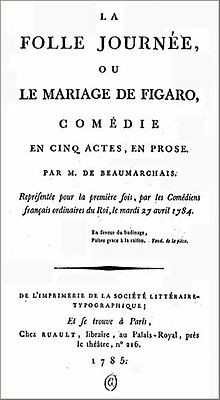The Marriage of Figaro(play)
| The Marriage of Figaro | |
|---|---|

Title page from the first edition of The Marriage of Figaro
|
|
| Written by | Pierre Beaumarchais |
| Characters | Figaro Count Almaviva The Countess Suzanne Marceline Chérubin Antonio Fanchette Bartholo |
| Date premiered | 1784 |
| Original language | French |
| Genre | Romantic comedy |
| Setting | The Count's castle near Seville |
The Marriage of Figaro (French: La Folle Journée, ou Le Mariage de Figaro ("The Mad Day, or The Marriage of Figaro")) is a comedy in five acts, written in 1778 by Pierre Beaumarchais. This play is the second in the Figaro trilogy, preceded by The Barber of Seville and followed by The Guilty Mother.
In the first play, The Barber, the story begins with a simple love triangle in which a Spanish count has fallen in love with a girl called Rosine. He disguises himself to ensure that she will love him back for his character, not his wealth. But this is all foiled when Rosine's guardian, Doctor Bartholo, who wants her hand in marriage, confines her to the house. The Count runs into an ex-servant of his (now a barber), Figaro, and pressures him into setting up a meeting between the Count and Rosine. He succeeds and the lovers are married to end the first part of the trilogy.
The Marriage was written as a sequel to The Barber. In his preface to the play, Beaumarchais says that Louis François, Prince of Conti had requested it. The play's denunciation of aristocratic privilege has been characterised as foreshadowing the French Revolution. The revolutionary leader Georges Danton said that the play "killed off the nobility"; in exile, Napoleon Bonaparte called it "the Revolution already put into action."
Thanks to the great popularity of its predecessor, The Marriage of Figaro opened to enormous success; it was said to have grossed 100,000 francs in the first twenty showings, and the theatre was so packed that three people were reportedly crushed to death in the opening-night crowd.
The play formed the basis for an opera with a libretto by Lorenzo Da Ponte and music by Mozart, also called The Marriage of Figaro (1786). In 1799, another opera based on the same play, La pazza giornata, ovvero Il matrimonio di Figaro, was produced in Venice with libretto by Gaetano Rossi and music by Marcos Portugal.
...
Wikipedia
